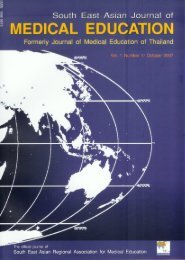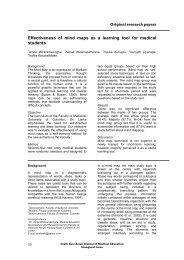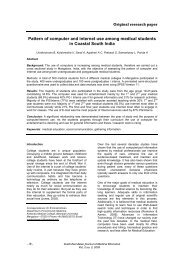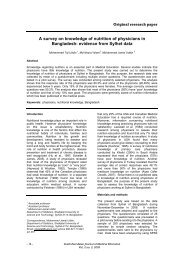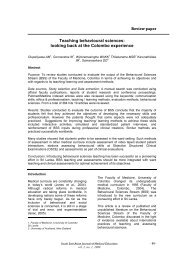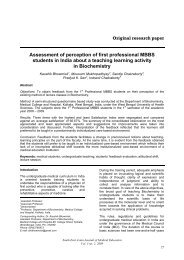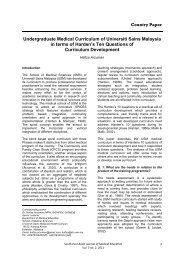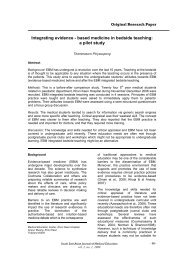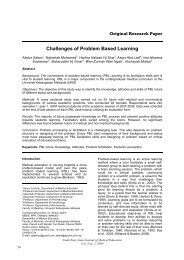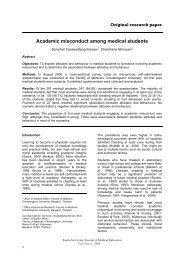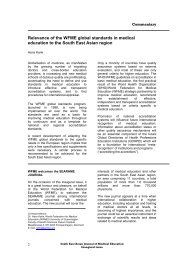Students' perception of the educational environment in a Medical ...
Students' perception of the educational environment in a Medical ...
Students' perception of the educational environment in a Medical ...
Create successful ePaper yourself
Turn your PDF publications into a flip-book with our unique Google optimized e-Paper software.
Some <strong>of</strong> <strong>the</strong> problem areas identified <strong>in</strong> <strong>the</strong><br />
study population have also been identified as<br />
problems encountered <strong>in</strong> medical schools with<br />
traditional curricula by Al Hazimi and<br />
coauthors (2004). They documented that<br />
students <strong>in</strong> traditional medical curricula<br />
perceived teach<strong>in</strong>g as be<strong>in</strong>g too teacher<br />
centered, over emphasiz<strong>in</strong>g factual learn<strong>in</strong>g<br />
with more authoritarian teachers. It was also<br />
observed that <strong>the</strong> students <strong>in</strong> <strong>the</strong>se<br />
<strong>environment</strong>s were more likely to feel tired,<br />
less able to memorize all <strong>the</strong>y needed and<br />
were less likely to enjoy <strong>the</strong> course. However<br />
<strong>the</strong> UCFM curriculum is not considered a<br />
traditional curriculum. Thus study<strong>in</strong>g <strong>the</strong><br />
<strong>perception</strong>s <strong>of</strong> a wider group <strong>of</strong> students<br />
compris<strong>in</strong>g students <strong>in</strong> <strong>the</strong> early phase <strong>of</strong> <strong>the</strong>ir<br />
course as well those who have completed <strong>the</strong><br />
course would enable a wider <strong>perception</strong> <strong>of</strong> <strong>the</strong><br />
<strong>educational</strong> <strong>environment</strong> created at <strong>the</strong><br />
<strong>in</strong>stitution and its actual impact on <strong>the</strong><br />
curriculum.<br />
Although <strong>the</strong> overall <strong>perception</strong> <strong>of</strong> <strong>the</strong><br />
<strong>educational</strong> <strong>environment</strong> at <strong>the</strong> UCFM was<br />
more positive, <strong>the</strong> global mean score <strong>of</strong> <strong>the</strong><br />
study sample was lower than what was<br />
observed <strong>in</strong> studies from University <strong>of</strong> Dundee<br />
and BP Koirala Institute <strong>of</strong> Health Sciences <strong>in</strong><br />
Dharan Nepal and was similar to <strong>the</strong> study<br />
results from Faculty <strong>of</strong> <strong>Medical</strong> Sciences,<br />
University <strong>of</strong> Sri Jayawardenapura <strong>in</strong> Sri<br />
Lanka. The entry criterion for state universities<br />
<strong>in</strong> Sri Lanka is based on <strong>the</strong> merit score<br />
obta<strong>in</strong>ed at <strong>the</strong> highly competitive National<br />
Advanced Level Exam<strong>in</strong>ation. The students<br />
who ga<strong>in</strong> entry to study medic<strong>in</strong>e are those<br />
who achieve high merit scores at this highly<br />
competitive exam<strong>in</strong>ation. Thus it is possible<br />
that <strong>the</strong> students are already academically<br />
challenged at entry and are more prone to<br />
stress dur<strong>in</strong>g <strong>the</strong>ir undergraduate studies. This<br />
may have contributed to similar global mean<br />
scores and sub doma<strong>in</strong> scores obta<strong>in</strong>ed for<br />
DREEM from <strong>the</strong> two Sri Lankan medical<br />
schools (UCFM and FMS/USJ) and to <strong>the</strong><br />
differences observed with <strong>the</strong> regional study<br />
from BP Koirala Institute <strong>of</strong> Health Sciences <strong>in</strong><br />
Dharan, Nepal.<br />
The students’ <strong>perception</strong> <strong>of</strong> emphasized<br />
factual learn<strong>in</strong>g lead<strong>in</strong>g to memorization and<br />
stress <strong>in</strong> <strong>the</strong> medical school may also be<br />
broadly rooted <strong>in</strong> <strong>the</strong>ir acquired study habits<br />
related to over emphasized factual learn<strong>in</strong>g for<br />
<strong>the</strong> entry level exam<strong>in</strong>ation. It may be possible<br />
to overcome <strong>the</strong>se problems by redesign<strong>in</strong>g<br />
<strong>the</strong> <strong>in</strong>duction course at entry level to address<br />
<strong>the</strong>se issues.<br />
Conclusion<br />
The senior batch <strong>of</strong> medical undergraduates<br />
compris<strong>in</strong>g <strong>the</strong> study population at <strong>the</strong> UCFM,<br />
perceived <strong>the</strong>ir <strong>educational</strong> <strong>environment</strong> to be<br />
more positive. Certa<strong>in</strong> problem areas and<br />
areas that require enhancement <strong>in</strong> <strong>the</strong> UCFM<br />
<strong>educational</strong> <strong>environment</strong> were identified for<br />
effective management <strong>of</strong> learn<strong>in</strong>g especially <strong>in</strong><br />
<strong>the</strong> students’ <strong>perception</strong> <strong>of</strong> teachers and<br />
students’ <strong>perception</strong> <strong>of</strong> atmosphere sub<br />
doma<strong>in</strong>s.<br />
Acknowledgements<br />
We gratefully acknowledge <strong>the</strong> contribution<br />
made by<br />
1. The senior batch <strong>of</strong> medical<br />
undergraduates <strong>of</strong> Faculty <strong>of</strong> Medic<strong>in</strong>e,<br />
University <strong>of</strong> Colombo for participat<strong>in</strong>g <strong>in</strong><br />
<strong>the</strong> study.<br />
2. Staff <strong>of</strong> <strong>the</strong> <strong>Medical</strong> Education and<br />
Research Centre (MEDARC), Faculty <strong>of</strong><br />
Medic<strong>in</strong>e, University <strong>of</strong> Colombo by<br />
provid<strong>in</strong>g guidance and advice.<br />
3. Staff <strong>of</strong> <strong>the</strong> Department <strong>of</strong> Community<br />
Medic<strong>in</strong>e, Faculty <strong>of</strong> Medic<strong>in</strong>e,<br />
University <strong>of</strong> Colombo by provid<strong>in</strong>g<br />
expert advice and guidance on statistical<br />
analysis.<br />
References<br />
Al-Hazimi, A., Za<strong>in</strong>i, R., Al-Hyiani, A., Hassan, N.,<br />
Gunaid, A., Ponnamperuma, G., Karunathilake, I.,<br />
R<strong>of</strong>f, S., McAleer, S. & Davis M. (2004)<br />
Educational <strong>environment</strong> <strong>in</strong> traditional and<br />
<strong>in</strong>novative medical schools: A study <strong>in</strong> four<br />
undergraduate medical schools, Education for<br />
Health, 17(2), pp. 192-203.<br />
Genn, J.M. (2001) AMEE <strong>Medical</strong> Education Guide<br />
No. 23 (Part 2): Curriculum, <strong>environment</strong>,<br />
climate, quality and change <strong>in</strong> medical education<br />
– a unify<strong>in</strong>g perspective, <strong>Medical</strong> Teacher, 23(5),<br />
pp. 445-454.<br />
Jiffry, M.T.M., McAleer, S., Fernando, S. &<br />
Maras<strong>in</strong>ghe, R.B. (2005) Us<strong>in</strong>g <strong>the</strong> DREEM<br />
questionnaire to ga<strong>the</strong>r basel<strong>in</strong>e <strong>in</strong>formation on<br />
an evolv<strong>in</strong>g medical school <strong>in</strong> Sri Lanka, <strong>Medical</strong><br />
Teacher, 27(4), pp. 348 – 352.<br />
Reem, R.A., Ramanarayan, K., Pallath, V., Torke,<br />
S. Perceptions <strong>of</strong> academic achievers and underachievers<br />
<strong>of</strong> learn<strong>in</strong>g <strong>environment</strong> <strong>of</strong> Melaka<br />
Manipal <strong>Medical</strong> College (Manipal Campus)<br />
Manipal, India, us<strong>in</strong>g <strong>the</strong> DREEM <strong>in</strong>ventory,<br />
South-East Asian Journal <strong>of</strong> <strong>Medical</strong> Education,<br />
1(1), pp.18-24.<br />
South‐East Asian Journal <strong>of</strong> <strong>Medical</strong> Education 15<br />
Vol. 4 no. 1, 2010




